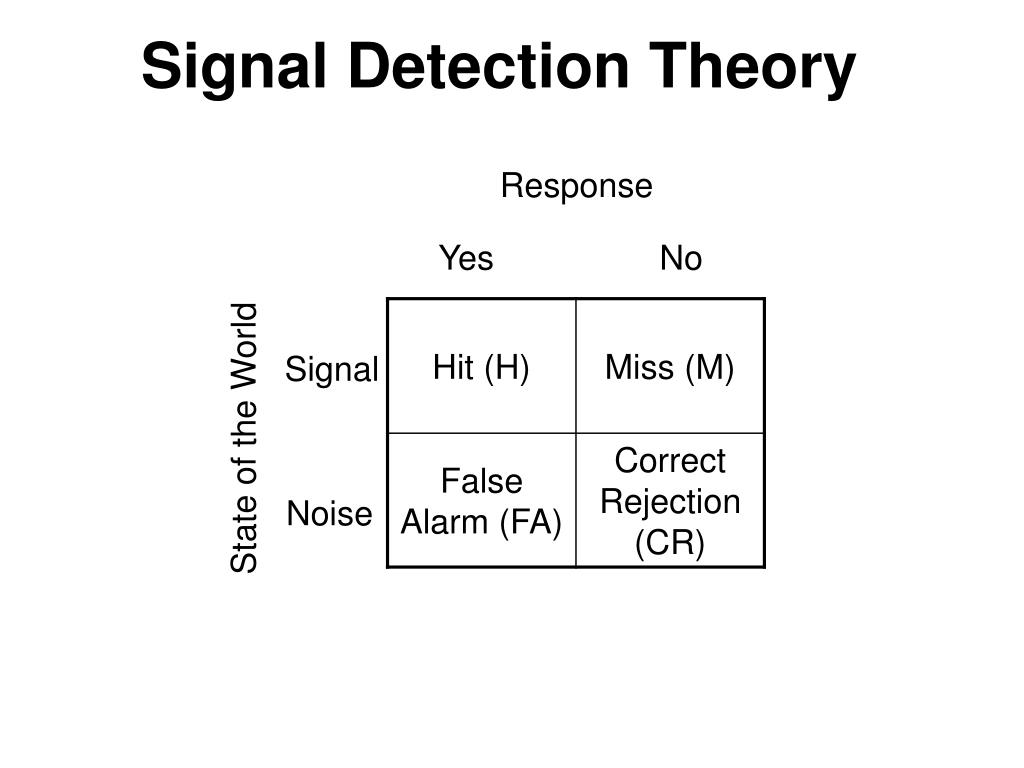
Signal Detection Theory in Psychology is a theory that determines an individual’s ability to detect, discriminate, recognize, and identify stimuli based on his level of sensitivity and bias. Signal Detection Theory Psychology Definition

It is a theory regarding the ways in which the choices are made. Thus, Signal Detection Theory is a theory that provides a precise language and graphic notation to analyze decisions in the presence of uncertainty. Therefore, to remove such challenges of ambiguity in decision making, the Signal Detection Theory was introduced. Such uncertainty may cause challenges in taking accurate decisions.

What is Signal Detection Theory in Psychology?Īs you already know, all reasoning and decision making takes place in the presence of some uncertainty. This led to the development of Signal Detection Theory and Receiver Operating Characteristics (ROC). Thus, to enable such professionals to make accurate decisions amidst great uncertainty, a collection of researchers introduced the concept of noise distribution in the early 1950s. These are quite ambiguous situations as the researchers and psychologists have to discriminate between the quite faint stimuli and make an accurate decision. They have to analyse a wide variety of psychological and neuroscience experiments where they have to make accurate decisions.Ī psychologist may have to decide whether a child he is treating has ADHD or not based on the score that he may get by administering the Child Behavior Checklist (CBCL). Researchers or psychologists in the field of psychology face similar situations. Likewise, during World War II, a radar operator had to decide whether any of the given signals represented an enemy airplane or not.Īs you can see, it is extremely important to make a correct decision in situations like these, otherwise the consequences are certainly going to be extreme. We humans come across a host of situations where we need to make a decision despite great uncertainty.įor instance, a radiologist while examining a CT scan has to make a decision amidst great uncertainty with regards to finding evidence whether there exists a tumor or not.

Signal Detection Theory Psychology Example.What is Signal Detection Theory in Psychology?.Thus, your ability to detect signals or noises has been affected by these factors. In this case, you may hear some slight noises that you might otherwise not hear if you were in a different situation that was not as threatening. For example, when you walk to your car that is parked in an empty parking lot late at night all by yourself, you might be much more aware of noises because the situation is somewhat threatening (you are primed and listening carefully to hear anything and everything).

Here is one that I found in one of my texts: "Signal Detection Theory holds that the detection of a stimulus depends on both the intensity of the stimulus and the physical and psychological state of the individual." And that's really all it is.Your ability or likelihood to detect some stimulus is affected by the intensity of the stimulus (e.g., how loud a noise is) and your physical and psychological state (e.g., how alert you are). I often like to change a complex psychological definition into a precise and clear one that everyone understands, but the definition for Signal Detection Theory is pretty straight forward.


 0 kommentar(er)
0 kommentar(er)
